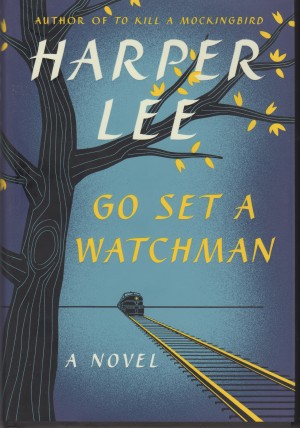
Go Set a Watchman by Harper Lee (2015. Harper. ISBN 9780062409850)
A confession. I didn’t read To Kill a Mockingbird as a teenager, as part of my sophomore English class like so many white American kids did. I didn’t dissect Lee’s monumentally successful and universally beloved first novel in my college English courses. And, up until I started teaching Paralegalism and Ethics at the University of Wisconsin-Superior a few years back, well into my late 50’s, I hadn’t watched the Academy Award winning film (Winner of Best Actor: Gregory Peck; Best Adapted Screenplay; and Best Art Direction; Nominated but did not win for Best Picture, Best Actress (Mary Badham as Scout), Best Director, Best Cinematography, and Best Score). It wasn’t until I was at a friend’s cabin, enjoying the summer sun in a hammock strung between two oaks next to a Minnesota lake that I read the book. That’s not true. I devoured the novel in one day! It was one of those stories that grips your gut and twists you in knots, compelling you to race through the pages so as to relieve the anxiety of not knowing how it ends. The movie, of course, is so true, so accurate to the characters and world Lee created with her prose, it is one of the greatest lawyer-driven films of all time, if not simply one of the greatest films of all time. So, as a latecomer to Lee’s original masterpiece (and of course, like everyone else, curious as to just how much Truman Capote’s hand is on its pages), when I heard that another manuscript written by Lee, an earlier rendition of Atticus and Jean Louise Finch and the town of Maycomb had been discovered hidden away in some nook or cranny, well, like a teenage boy drawn to a Playboy centerfold, I just had to get a copy and read Go Set a Watchman.
Let me be perfectly clear. There is so much wrong with this book, in terms of consistency of character, plausibility, dangling plot architecture, and dialogue that, if it didn’t have Miss Lee’s name on the cover, it would have never seen the light of day. This is not to say that Miss Lee doesn’t understand the mechanics of writing. She is certainly able to string words into sentences into paragraphs into pages into chapters. But the sum total of the work the author expended to transpose her thoughts to words on paper should have remained under lock and key regardless of its impact upon her authorial legacy. Replace the name “Harper Lee”, embossed across the cover of this book with the name “Mark Munger” and the writer of this critique would be hard pressed to sell ten copies of this long-winded diatribe about racial relations in the Deep South on the heels of the United States Supreme Court’s iconic desegregation decision in Brown v. The Board of Education. The fact is nothing much, other than dialogue between Jean Louis (formerly known as Scout) and a small cast of characters, really happens in this book. Oh, there’s the inkling of a plot: A black man accidentally runs over and kills a white man with a car. Atticus, the prototype American idealist and defender of the downtrodden in To Kill a Mockingbird is retained to represent the defendant. The fact that Atticus takes on the defense not, as in the original Lee effort, to ensure that a black man has a decent lawyer handling his case in a search for truth and justice, but merely to claim, after the driver is invariably convicted of manslaughter, that justice was served because a black man had a fair trial, is disquieting. The fact that the manslaughter subplot disappears after being introduced and nary another word is said about the case, the defendant, or the end result is a major defect in storytelling.
One could go on and on about the nonsensical hypothesis advanced by this tale: the complete change of the leopard’s (Atticus’s) spots. In To Kill a Mockingbird, Lee presents the world with an honest lawyer, a man of integrity, a defender of what is right in the face of massively unfair prejudice. With the wave of her magical pen, Lee reveals that Atticus Finch was never the hero we all supposed, but is instead, a card carrying member of the Klan and that, due to the Brown decision, Finch’s native racism and disdain for those of dark skin compels him to join a citizen’s committee hell bent on keeping the racial status quo in bucolic Maycomb. In short, Lee trashes an icon of American literature without any plausibility in the story or character development. I should be kinder: I understand that Miss Lee isn’t of sound mind, or at least, of agile mind at the advanced age of 89. There is much dispute as to whether she ever intended this piece of journalist scribbling to see the printing press. (See https://en.m.wikipedia.org/wiki/Harper_Lee ). I tend to believe that Miss Lee, if this indeed is the forerunner to her seminal novel, would have preferred this story to have remained in her drawer with her delicates and stockings!
I so wanted to write a review that concluded that this supposedly earlier look (in terms of when it was written) at Atticus and Scout, while a bit rough around the edges, was a worthwhile read for lovers of Lee’s masterpiece if only to explore the writerly process of an well respected writer. But there’s so much wrong with this book, so much in this tale that is at odds with what To Kill a Mockingbird has become in American cultural history, I would highly recommend that others not waste their time on Go Set a Watchman as I have. Hold on to the Atticus Finch you know and love. He’s a better man than the jerk portrayed in this novel.
2 stars out of 5. Save your money!
Peace.
Mark



Our book club read both books this summer. I loved “to Kill a Mockingbird” and I was totally disappointed in “Go Set A Watchman” I totally agree with everything you said in your review.
Thanks for reading, Jan. Not everything an author, even Harper Lee, writes is meant to be published!
Great get together the other night!
Mark